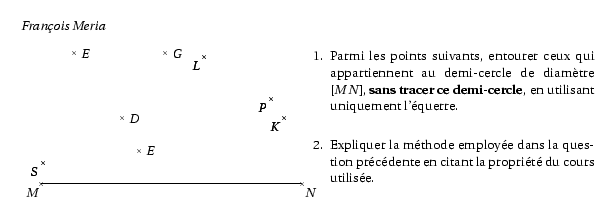
%@Auteur: François Meria\par \begin{multicols}{2} \begin{flushright} \pspicture(8,4.2) \pstGeonode[PointSymbol=x,PosAngle={-135,-45}](0,0){M}(8,0){N} \pstLineAB{M}{N} \pstMiddleAB[PointSymbol=none,PointName=none]{M}{N}{I} %\pstArcOAB[linecolor=false]{I}{N}{M} \pstCurvAbsNode[PointSymbol=x,PosAngle=-135]{I}{N}{K}{60} \pstCurvAbsNode[PointSymbol=x,PosAngle=-135]{I}{N}{L}{150} \pstCurvAbsNode[PointSymbol=x,PosAngle=-135]{I}{N}{P}{80} \pstCurvAbsNode[PointSymbol=x,PosAngle=-135]{I}{N}{S}{340} \pstGeonode[PointSymbol=x](2.5,2){D}(1,4){E}(3,1){E}(3.8,4){G} % \pstCircleAB{M}{N} %\pswedge(4,0){4}{0}{180} \endpspicture \end{flushright} \par\columnbreak\par \begin{enumerate}[1.] \item Parmi les points suivants, entourer ceux qui appartiennent au demi-cercle de diamètre $[MN]$, \textbf{sans tracer ce demi-cercle}, en utilisant uniquement l'équerre. \item Expliquer la méthode employée dans la question précédente en citant la propriété du cours utilisée. \end{enumerate} \end{multicols}